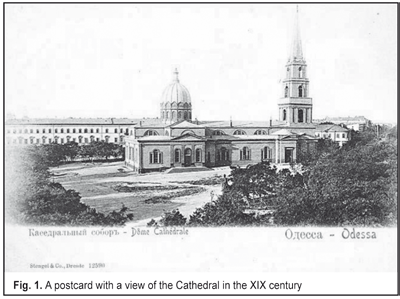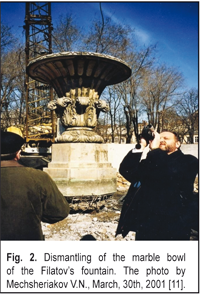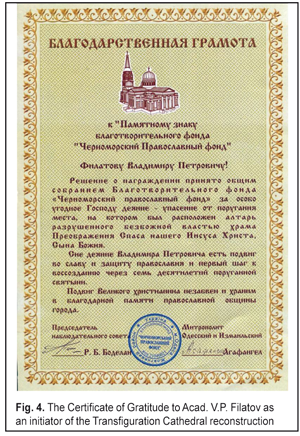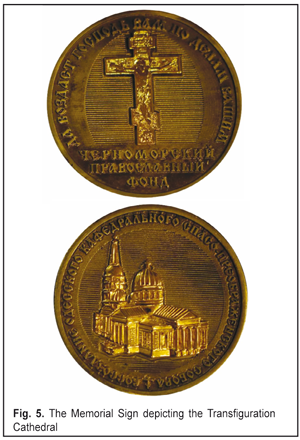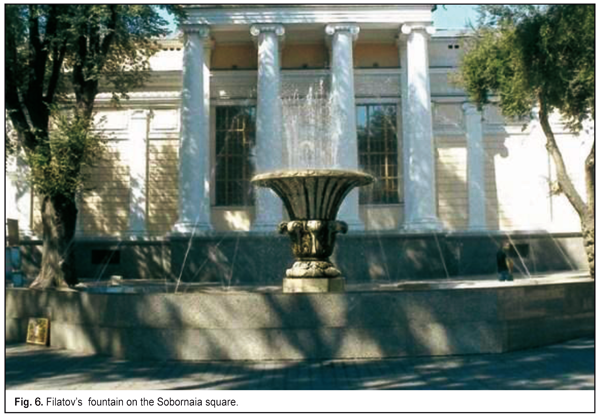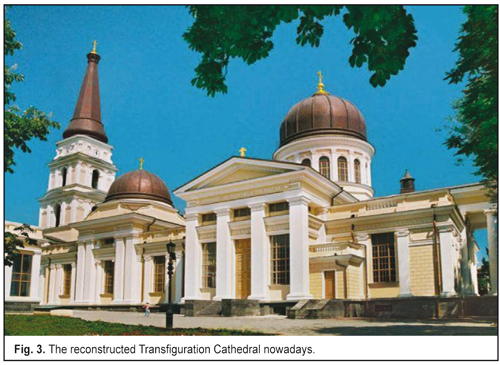J.ophthalmol.(Ukraine).2017;6:79-82.
|
https://doi.org/10.31288/oftalmolzh201767982 Contribution of academician V.P.Filatov to reconstruction of Transfiguration Cathedral in Odessa D.Yu. Benik1, a Postgraduate Student, N.F. Bobrova2, Dr Sc (Med), Prof., D.V. Aleksa, an Internship Doctor 1Ukrainian Theological Academy of Carpathian University 2Filatov Institute of Eye Disease and Tissue Therapy Odessa, Ukraine E-mail: filatovbobrova@gmail.com, dashaalexa0508@gmail.com «…there is nothing concealed that will not be disclosed, or hidden that will not be made known» Gospel of St. Matthew, 10.26
Introduction It is far from always that the many-sidedness of an outstanding person can completely be recognized, understood, and appreciated by his contemporaries. Much remains concealed in spite of publicity, availability, a great number of publications, etc. This is true for Academician V.P. Filatov, a most influential ophthalmologist of his time, a genius inventor, a talented physician and surgeon, a founder of the ophthalmological school in Ukraine, an irreplaceable leader of the largest Scientific Research Institute of Eye Diseases and Tissue Therapy initiated by him and named after him. At the same time he had many other talents: he wrote stories [1, 2] and poems [3], draw pictures [8], participated in many, as we would call them now, “social projects” as meetings of Odessa artist, literary, and other societies. V.P. Filatov had unquenchable optimism, ever-living creative energy, and willing to cultivate kindness and mercy. Contemporaries loved and appreciated Academician V.P. Filatov both as a professional ophthalmologist and as a friend and a man of high integrity standards. Here is a poem devoted to him by Alexander De Ribas in 1928 [4]: Oh, friend, oh doctor! Cure us those who’re dazzled There is no fear when you’re near, oh, darkness healer. Live in our midst, for we’re diseased and tired, Live in our midst, for we’re completely darkened And where will be you, there will be light
Some of his activities were behind-the-scenes and we sometimes get to know them occasionally with the course of the time. The purpose of the paper was to show the contribution of Academician V.P. Filatov to the reconstruction of Transfiguration Cathedral in Odessa. Historical reference. The Transfiguration Cathedral is special among churches of Odessa since it is the largest Orthodox Church in Southern Ukraine. It was founded in 1794 and consecrated in 1808 [7, 12]. On reconstruction the Cathedral Chapel was re-consecrated in 2001, the Lower Churcha and the Upper Church were consecrated in 2002 and 2003, respectively. The Transfiguration Cathedral is situated on the central square of Odessa which is called Sobornaia after the name of the church on it. An outstanding event, the consecration of the city of Odessa, took place in August 1794. At the same time, the site for the Church of Saint Nicholas to be erected was also consecrated [6]. The first foundation stone was laid in 1795. According to archival records and literature data, Gavril B?nulescu-Bodoni, Metropolitan of Ekaterinoslav, trusted to do the work on construction of a stone church building to V. Vonrezant, an acting engineer captain and an architect. The construction of the main building finished on May, 20th, 1808 and on May 25th, 1808, the Church's main altar was consecrated in the honor of the Savior's Transfiguration, the left one was consecrated in the honor of St. Spyridon and the right one was consecrated in the honor of St. Nicolas by Platon, Archbishop of Ekaterinoslav, and, thereafter, the Church was renamed into the Church of the Savior's Transfiguration. Afterwards, the Church was rebuilt and reconstructed many times; the last reconstruction was in 1900 when the Church turned into a proportional imposing cross-domed church [12]. The Transfiguration Cathedral is a valuable architectural monument of Odessa (Figure 1). In the early XIX century it became one of the largest Orthodox churches of the North Black Sea region and the main church in Eparchy of Odessa and Kherson. In the years that followed, the Sobornaia Square held all important events and celebrations; it became the main square in the city.
The Bolsheviks decided to destroy the Church in 1936. The municipal government wanted to organize entertainments for citizens on the site of the church, and public conveniences on the site of the Church’s altar. It turned out to be difficult to destroy the Church; the building was not blown up since the Church’s stones were fixed with egg yolk solution. A heady scheme was used: to blow up the bell-tower for it, when falling down, to destroy the Church [5]. So that was done. The Church’s stones were used afterwards to build a secondary school No121. Academician V.P. Filatov could not stay indifferent to this situation. Despite the fact that in 1936 Experimental Institute of Eye Diseases was put into operation and he was highly engaged in solving many related problems, V.P. Filatov, without saying to anyone, gave a notice to the City Hall with a preposition to place a fountain on the site of the destroyed altar and he managed to obtain a positive decision. On the site of the destroyed church altar was set a wide bowl of the fountain with a marble flower-shaped vase in the center. Vladimir Filatov’s own funds were used for building and in the year of 1940 the fountain started working. Thus, the most sacred place of the Church, its altar, was saved from desecration. The fountain on the Sobornaia Square became the favorite resting place of Odessa citizens, giving the chillness and freshness in canicular summer days. Bit by bit, the reminiscence of the former church passed from the record of a new generation of Odessa; the fountain seemed to be always on that place and nobody wondered when and why it had been founded. Nobody was told anything by Academician V.P. Filatov who was involved in matters of the highly developing institute which was created by him and was rising to international fame by new corneal transplantation technologies, advancing tissue therapy, Filatov’s flap plastic surgery and other important ophthalmic issues. The time passed by very quickly and in 1956, citizens of Odessa said farewell to Academician V.P. Filatov who had fulfilled his purpose on the Earth. When the Church was reconstructed in 1997, they started diggings and laying out the remained old building foundation. This is when everyone found out that the fountain had been placed on the site of the altar (Figure 2) [11]. When studying the archival records, the history of its creation was discovered and it became clear that it was Academician V.P. Filatov who had initiated that.
In 1999, the Ukraine's Cabinet of Ministers included the Church in "The Program for Reconstruction of the Outstanding and Lost Monuments of the Ukraine's History and Culture". The Transfiguration Cathedral was reconstructed what is called all together. A charitable organization, the Black-Sea Orthodox Foundation, was established; many Odessa’s enterprises, Eparchy of Odessa, the mayor and citizens of Odessa. Clergymen, architects, historians, builders, businessmen – they all united for revival of the lost Sanctuary [13]. And as early as 6 years later, the Transfiguration Cathedral, raised from the ashes as Phoenix with its snow-white walls, golden domes and a new bell tower, held the first service. Academician V.P. Filatov was posthumously awarded the Certificate of Gratitude as the first participant of the Church’s reconstruction (Figure 4), in which his civil feat was described in details: “for an act particularly pleasing to the Lord - salvation from the desecration of the place where the altar of the Church of the Transfiguration of Our Savior, Jesus Christ, the Son of God, was destroyed by the godless government. This act of Vladimir Petrovich is a feat and the first step to the re-creation in seven decades of the desecrated Sanctuary”. In addition to the Certificate, there was the Memorial Sign, a medal depicting the Cathedral (Figure 5); both the Medal and the Certificate are reposed in the Filatov Museum and Exhibition Complex [9]. The Academician was not frightened to behave like this at that scary time, after all, the work of all his life – the creation of the scientific research institute worthily named after him – could be at risk.
Before the Cathedral reconstruction there were two fountains on the square. Closer to the Preobrazhenskaia Square there was a small old fountain erected in 1873 on the occasion of the opening of the first water supply system in Odessa, in which the water from the Dniester first appeared in Odessa. The bowl of this fountain did not survive to this day and it did not work after so many years. The second fountain, big and working, was the one created by Academician V.P. Filatov In 2003, the General Assembly of the Black Sea Orthodox Fund decided to merge the two fountains – a new fountain was reconstructed with the bowl of Filatov’s fountain on the historical site of the old fountain (Figure 6). The fountain is still located before the altar of the recovered Transfiguration Cathedral (Figure 7). In September 2004, when the 210th Anniversary of Odessa was celebrated, the fountain was grandly opened and blessed. Popularly, it has got the name of Filatov’s fountain. The Institute’s workers and all involved Odessa citizens hope that thin name will officially be fixed and registered in all guidebooks of the city.
References
1.Filatov VP. [A lifelong story]. Kovalenko NB, comp. Odessa:Aprel;2001. 347 p. In Russian.
2. Filatov VP. [The last speech]. Donetsk:Nord-Press;2008. 456 p. In English.
3. Filatov VP. [Life… and Thoughts… and Love. Selected poems]. Kovalenko NB, comp. Odessa:Reklam servis; 2008. 219p. In Russian.
4. Filatov VP. [Don’t say with sorrow they are not but with gratitude they were…] Kovalenko NB, comp. Odessa:Aprel;2013. 151 p. In Russian.
5. Hegumenia Serafima. [Cathedral]. Odesskii vestnik. 118; 1994. In Russian.
6. [History of Orthodox Church in Ukraine]. Chetverta Khvylia; 1997. 292 p. In Ukrainian.
7.Historical notes about Odessa Cathedral. Odesskii vestnik.1857;35. In Russian.
8. Kovalenko NB. [A booklet dedicated to 130th birth anniversary of acad. V.P.Filatov]. Odessa:Pechatnyi dom; 2005. 33 p. In Russian.
9. Kovalenko NB. [Pages of our history]. Odessa: Aprel;2017. 380p. In Russian. (In printing].
10. Krpichnikov A. [A century of Odessa. August, 22nd, 1974- August 22nd, 1894]. Odessa. 1894.
11. Meshcheryakov VN. [Reconstruction of Odessa Transfiguration Cathedral]. Odessa:Feniks; 2017. 453p. In Russian.
12. Tymofienko VI. [Cross-dome churches in southern towns of Ukraine]. Pratsi Tsentru pamyatkoznavstva. K.:1992;1:90-103. In Ukrainian.
13. Filipchuk V. [Black oil and red roses]. Kiev:Novyi Druk; 2016. 391 p. In Russian.
|

